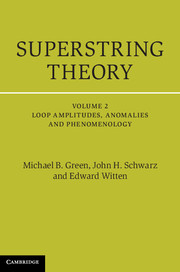Book contents
- Frontmatter
- Contents
- Preface to the 25th Anniversary Edition
- 8 One-loop diagrams in the bosonic string theory
- 9 One-loop diagrams in superstring theory
- 10 The gauge anomaly in type I superstring theory
- 11 Functional methods in the light-cone gauge
- 12 Some differential geometry
- 13 Low-energy effective action
- 14 Compactification of higher dimensions
- 15 Some algebraic geometry
- 16 Models of low-energy supersymmetry
- Bibliography
- References
- String Field Theory
- Index
13 - Low-energy effective action
Published online by Cambridge University Press: 05 September 2012
- Frontmatter
- Contents
- Preface to the 25th Anniversary Edition
- 8 One-loop diagrams in the bosonic string theory
- 9 One-loop diagrams in superstring theory
- 10 The gauge anomaly in type I superstring theory
- 11 Functional methods in the light-cone gauge
- 12 Some differential geometry
- 13 Low-energy effective action
- 14 Compactification of higher dimensions
- 15 Some algebraic geometry
- 16 Models of low-energy supersymmetry
- Bibliography
- References
- String Field Theory
- Index
Summary
The particle spectrum of a string theory consists of a finite number of massless states and an infinite tower of massive excitations at a mass scale characterized by a fundamental parameter – the string tension or Regge slope. As has been explained in previous chapters, this parameter must be of order the Planck mass (1019 GeV) in order that the graviton interact with the usual Newtonian strength. If one wishes to give a phenomenological description of the consequences of string theory for lowenergy physics, it should not be necessary to describe explicitly what the massive states are doing. It is natural, instead, to formulate an effective action based entirely on fields that correspond to massless, or at least very light, degrees of freedom only. Such a description turns out to be useful not only for a phenomenological analysis, but even as a framework for addressing certain theoretical issues, such as the occurrence of anomalies.
The infinite set of point-particle fields that arise in string theory consists of a finite number of massless fields, which we collectively represent for the moment by ϕ0, and an infinite number of heavy fields collectively represented by ϕH In principle, it must be possible to describe string theory by a classical action S(ϕ0 ϕH (or, at the quantum level, a quantum effective action) governing these fields. At present, we do not have really satisfactory ways to formulate and understand the exact classical action S(ϕ0, ϕH).
- Type
- Chapter
- Information
- Superstring Theory25th Anniversary Edition, pp. 307 - 362Publisher: Cambridge University PressPrint publication year: 2012



